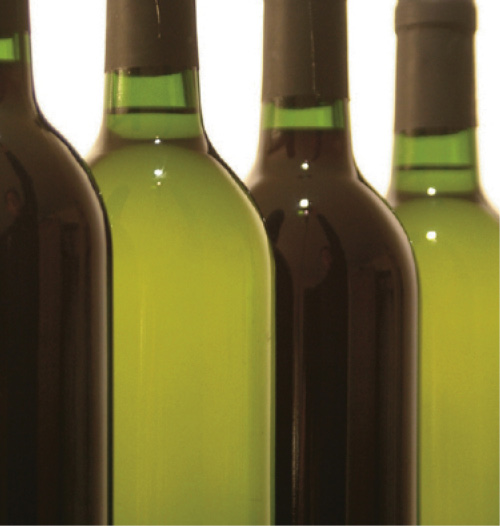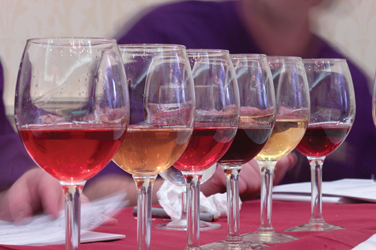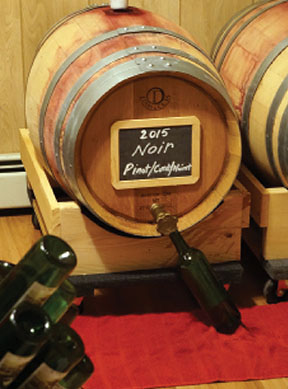
It was the writer Mark Twain who phrased it best, “Clothes make the man. Naked people have little or no influence on society.” What does this have to do with wine bottles? Quite a lot, really. Next time you have occasion to be in the wine aisle of your local store, look at the shapes, colors and sizes of the different bottles. Chances are your wine purchase will be influenced by the look of the bottle nearly as much as the variety of grape or the cost of the contents. The package makes the product.
While there’s no definitive rule which states that a particular variety of wine must be stored in a specific style of bottle, winemakers have found their wines are better accepted if packaged in their traditional vessels. The preference to pair a wine with a bottle of a particular style, size and color is as much history as habit and dates back to the dawn of viniculture itself.
Bottles through time
Archeological excavations in the Near East have uncovered numerous glass and ceramic containers dating back to 2,000 BC that clearly were intended for the transport and storage of wine. As Roman armies expanded their influence beyond the Mediterranean into what would later become France and Germany, they took with them a thirst for wine. After taking firm root in Europe, wine-drinking then followed explorers across the Atlantic Ocean to the colonies.
As early as 1660 AD there are records of wine and spirits being shipped from Europe to the New World. Shipping records mention hand-blown bottles with rounded shoulders and flattened sides, called a “chestnut” style. The leading producers of bottles at this time were the English and the Dutch.
By the mid-1800s bottle necks had grown longer, the “kick-ups” in the bottom were more pronounced and the containers were getting taller overall. The most common colors, determined mostly by the minerals available to the local bottle-maker, were aqua, green and brown. By 1860, the straight-sided, cylindrical container — the prototype of the modern wine and spirit bottle — had emerged.
Why certain styles of bottles seem linked to a specific geographical region remains clouded. Why, for example, does the tall brown Hock, or Rhine bottle as it is also called, remind us of the sweet wines of the Alsace and Germany, while the dark green Bordeaux bottle we would associate with a vineyard in France? Perhaps manufacturing equipment and techniques developed independently in each area of Europe during the 1800s and evolved a unique vessel that has endured to this day. Bottle-makers may also have been influenced by vintners in that region, who requested certain shapes or colors because they felt it suited their style of wine. What was born of necessity ten generations ago appears today to be a comfortable mix of history and marketing.
History aside, one thing is clear: Wine bottles come in all sizes, shapes and colors. When the time comes to bottle your batch, select a bottle that enhances the character of your wine and expresses your pride in the finished product. Here are some points to consider.
Pick the Right Size
Typical bottle sizes in the U.S. are 375 milliliter (also called a “split”), the 750-milliliter standard bottle and the 1.5 liter large bottle. Despite slight variations in the neck diameter, all three sizes work nicely with the most common corks (#7, #8, and #9). There are larger bottles available, of course, but the diameter of cork required to stopper them exceeds the chamber of most corking machines, so cork insertion can be a bit of a problem.
Splits are great if you have a sweet wine, like ice wine or port, which you usually drink in small amounts. They’re also perfect if you want to give the wine as a gift and need as many bottles as possible for your thirsty relatives. Plus, splits make for a nice “single-serving” size to accompany a solo meal.
The upside of the big 1.5 liter bottles is that you have fewer bottles to clean and sanitize at bottling time (a pretty big bonus!). The downside is that you’re less likely to finish 1.5 liters at a single sitting, so the leftover wine will lose some quality if you leave it hanging around in the bottle for long.
A 500 mL bottle is also popular in some decorative bottle lines and is used for ice wines, oils and vinegars. One popular decorative style is the Bellissima, a tall, cylindrical bottle with shoulders and a long neck. Generally the more exotic the bottle style, the higher the price.
Coordinate your Color
Color is another matter of choice for the winemaker. Generally there are two shades of green: Champagne green is a dark, almost opaque forest hue; dead-leaf green is a lighter, more yellow shade.
Antique and smoke are unique choices. Much like their names, antique is a deep olive green and smoke is a dark gray color, hinting at brown. Both are extremely versatile colors, most often used for red wines and Fumé Blancs.
Brown (or amber) is more rare. Ports and sherries are often packaged in brown and the sweeter wines of Germany have historically been connected with this tint.
Clear (or flint) is popular for winemakers who want to show off the color of their wine. The popularity of White Zinfandel is testimony to the value of a bottle without color: It showcases the beautiful pink tint of the wine. Some wineries are even using clear bottles to display the bright colors of synthetic corks that match their labels. It’s wine marketing at its best.
Possibly the rarest color is sapphire blue. Because blue is a non-traditional shade its use is seen mainly as a marketing tool. But such a cool color can evoke an association with a crisp, fresh wine. It’s sometimes used for aromatic or dessert wines. And the bottles are so pretty, they usually find themselves decorating a window sill.
Beyond aesthetics, consider storage when you pick a bottle color. Ultraviolet rays (sunlight, in other words) can do some serious damage to wine over time; that’s one of the reasons wine is stored in dark cellars. Wines that are going to be consumed quickly — like a light, fruity white — could be bottled in clear glass. Wines that age longer, like reds, should almost always go in dark bottles.
Select the Right Shape
Bottle shapes are easily grouped into four categories: Bordeaux, Burgundy, Hock and Specialty.
A Bordeaux bottle (also called Claret) has pronounced high shoulders and is perhaps most associated with Bordeaux-style wines such as Cabernet Sauvignon and Merlot. It often has a deep “punt,” also called a kick-up, in the bottom of the bottle. The punt is supposed to hold sediment when the wine is poured or decanted. Since the majority of wines today are filtered and not cellared for years, the punt has taken on a more symbolic nature.
According to The Home Winemaker’s Companion by Philip Ward (Lyons and Burford, 1994), the Bordeaux shape originally was developed with storage in mind. Because the reds are aged on their side to keep the cork moist, the high shoulders trap and keep sediment away from the cork. The high shoulders also allow Bordeaux bottles to be neatly stacked on top of each other into a stable pyramid for long-term storage.
The Burgundy-style bottle has less-pronounced shoulders and is commonly used for Chardonnay and Pinot Noir. It often has a punt and comes most often in dead-leaf green. Because of the sloping shoulders, Burgundy bottles won’t stack as stably for storage.
The Hock bottle (also called the Rhine or Alsace) is tall and slender and is often used for Gewürztraminer, Riesling, and dessert wines. It comes in a variety of colors, most often brown or clear.
Into the Specialty category falls the Champagne bottle. While standard bottles are not made to handle much pressure, the Champagne bottle is thicker and more sturdy. The bottle has a flair on the neck and requires a special cork or stopper and a wire bail to hold the stopper in place as pressure builds inside. It has a deep punt to facilitate the collection of yeast in the traditional production of Champagne or sparkling wine. One caution: Don’t put a sparkling wine in any other kind of bottle; it could explode.
Other specialty bottles include the tall Belissima, the tapered Flute and the Port or Sherry bottle. All of these are crafted in a variety of unique shapes.
Weigh the Price
How much should you pay for a brand-new wine bottle? According to Gary McMahon of Pacific Coast Container in Vancouver, Washington, the cost of a wine bottle is based on several factors.
McMahon says demand for a particular bottle fuels production and can therefore help hold prices down. Factories using modern “press and blow” technology can blow more bottles with a lighter weight than traditional blown-glass manufacturing. While color might seem to play a key role in price determination, McMahon says the lighter weight of the mass-produced bottles is more of a factor. The lighter bottle uses less material and costs less to ship from point A to point B. McMahon says that choosing a bottle with a unique shape or color will usually cost more simply due to low demand.
Purists insist on using only new bottles, and they pay a bit for the premium. A case of new bottles costs between $8 and $13 (you need two cases to bottle a five-gallon batch). Many shops also offer bottles that have been rewashed and sanitized. These are commercial bottles collected as you would at home but all the work has been taken out. Winemakers who use re-washed bottles can reserve the monetary savings for the final touch: bottle dressing.
Don’t Go Naked
Why spend time giving life to your wine and carefully selecting the bottle if you intend to send it out in the world naked? When you give your wine as a gift or open a bottle at the table it should be dressed to the hilt. Most winemaking shops offer a wide selection of heat-shrink hoods (also known as “capsules”) and customized labels for every occasion. These shops are ready to help you with your cork selection and may even have boutique gift boxes if you will be offering your homemade wine as a present. They are a great resource and they want to help you.
Wine is not a cheap commodity to be subjected to the indignity of storage in an unlabeled, screw-top jug. It is a living force, as individual as you are, begging to be given an identity. With a carefully chosen bottle, label, cork and shrink seal, your simple fermented beverage is transformed into a work of art, commanding praise from all who drink it. Indulge your wine. It deserves no less!
THE SHAPE OF THINGS
Bordeaux (Claret): High shoulders. Most often seen in champagne green or clear. Used for big reds: Cabs, Bordeaux, Zinfandel, Merlot. Whites include Sauvignon Blanc and Chenin Blanc.
Burgundy: Sloping shoulders. Usually seen in dead-leaf green or clear. Used for Pinot Noir, Chardonnay, Muscat, Pinot Blanc, Pinot Gris, Beaujolais. Many fruit wines.
Hock (Rhine or Alsace): Tall and slender. Usually comes in clear, dead-leaf green or brown. Used for Riesling, Gewürz-
traminer, Mosel, ice wine and most dessert wines.
Specialty: In brown: used for Sherry, Port. In green: used for Champagne or sparkling wines. In any color: Ice Wine.







